Gambia
Gambia new 2019 note family (B235 - B240) confirmed
18 08, 2019 12:37 Category: Africa
On 6 August 2019, the Central Bank of The Gambia introduced a completely new banknote family with native birds instead of the portrait of former President Yahya Jammeh.
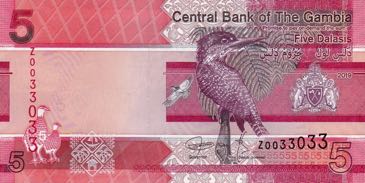
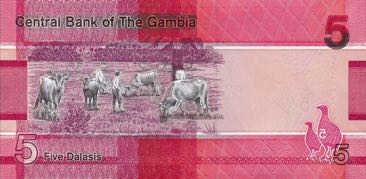
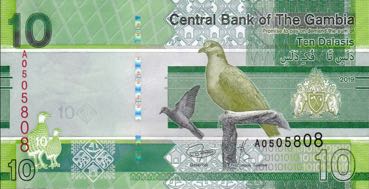
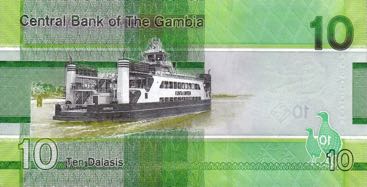
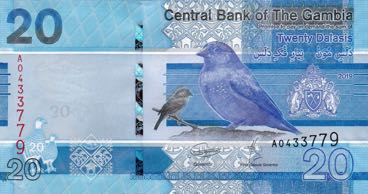

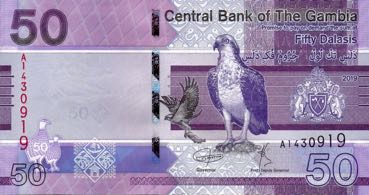
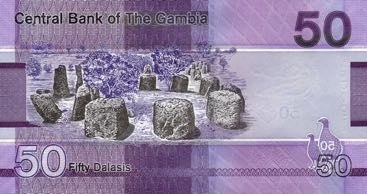
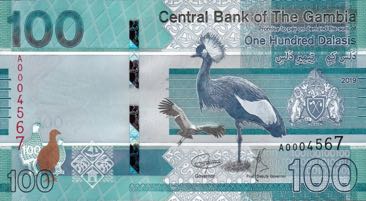

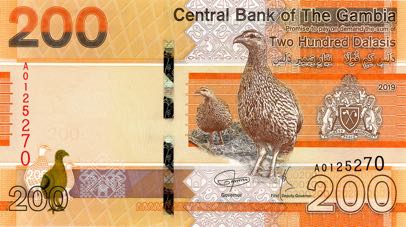

Courtesy of Andrea Bossi, Manuel Pires Horta Rosa, and Michel Daspre.












Courtesy of Andrea Bossi, Manuel Pires Horta Rosa, and Michel Daspre.
West African States adopt eco as common currency to be introduced in 2020
02 07, 2019 10:13 Category: Africa
According to a CNN article dated 1 July 2019, the Economic Community of West African States (consisting of Benin, Burkina Faso, Cabo Verde, Cote d'Ivoire, The Gambia, Ghana, Guinea, Guinea-Bissau, Liberia, Mali, Niger, Nigeria, Senegal, Sierra Leone, and Togo) has adopted the name “eco” for a planned single currency to be used in the region. Originally intended to be launched in 2000, the common currency has been postponed multiple times, and the newest target date is 2020.
Gambia new notes reported to be introduced July/August 2019
31 05, 2019 13:59 Category: Africa
On 31 May 2019, the Central Bank of The Gambia announced that it would introduce a completely new banknote family of 5, 10, 20, 50, 100, and 200 dalasis within two or three months. The new banknotes will show the different faces of The Gambia and its natural resources. These will not have the portrait of former President Yahya Jammeh.
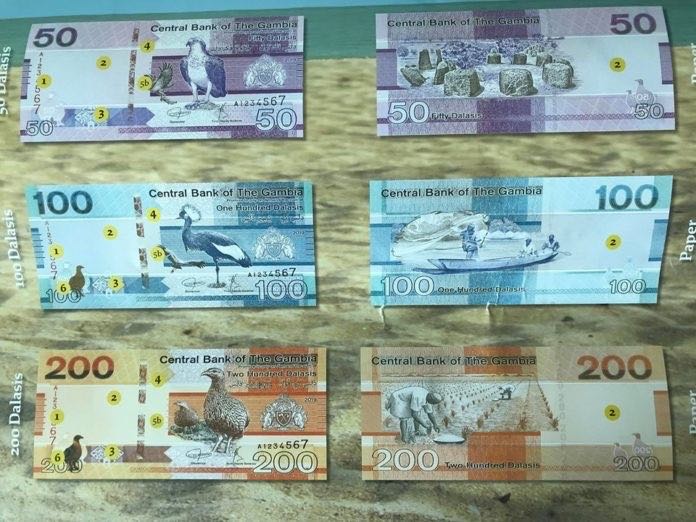

Gambia new sig. 100-dalasis note (B227c) confirmed introduced 11.06.2018
29 11, 2018 09:41 Category: Africa

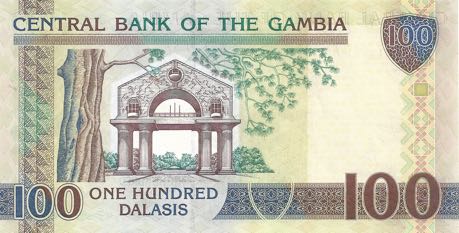
Courtesy of Claudio Marana.
Gambia new signature 50- and 100-dalasis notes (B225d, B227c) reportedly introduced 11.06.2018
15 06, 2018 12:27 Category: Africa
According to a press release dated 11 June 2018, the Central Bank of The Gambia has introduced 50- and 100-dalasis notes like preceding issues, but with new signatures to meet currency demands while a new family of notes is printed.
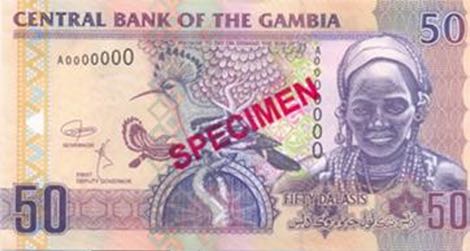
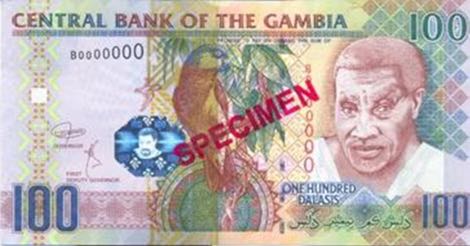
Courtesy of Claudio Marana.


Courtesy of Claudio Marana.
Gambia reportedly to issue reprinted notes in February 2018
24 11, 2017 09:05 Category: Africa
After a contested presidential election in 2016, long-time incumbent President Yahya Jammeh eventually stepped down on 21 January 2017, to be replaced by Adama Barrow as The Gambia's third president. According to an article in The Point dated 24 November 2017, the governor of the Central Bank of The Gambia, Bakery Jammeh, indicates that in February 2018 the bank will begin replacing notes featuring the portrait of former President Jammeh (B228 - B234) with reprints of the preceding issues, the so-called "Family" notes bearing images of typical Gambians. These notes will be used throughout 2018, giving the bank time to design and print an entirely new series of notes with the latest security features. Ironically, history seems to be repeating itself. Following the overthrow of President Jawara in a coup d’état led by then Lieutenant Jammeh on 22 July 1994, the bank replaced notes featuring Jawara's portrait (B201 - B212) with the original "Family" notes (B213 - B216) in 1996.
Gambia new dalasi note family confirmed
26 04, 2015 11:40 Category: Africa
On 25 February 2015, the Central Bank of The Gambia unveiled a new family of notes, which now includes a 200-dalasi note, twice the size of the previously largest denomination. All of the redesigned banknotes bear the portrait of President Yahya Jammeh and are smaller in size than the preceding issues. The 20-dalasi note will replace the 25-dalasi note which will continue to be legal tender and will continue to circulate until it is fully withdrawn over time.
Originally scheduled for 30 March 2015, the issuance of these notes was postponed until 15 April 2015 due to a delay in the receipt of publicity materials from the printer, De La Rue.
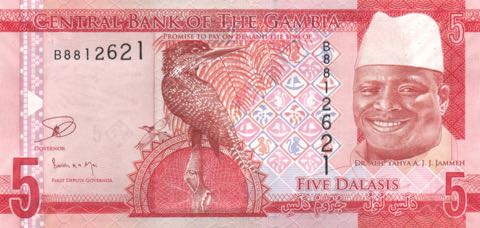
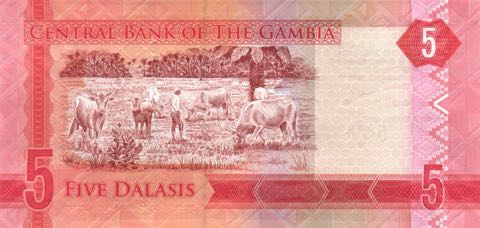
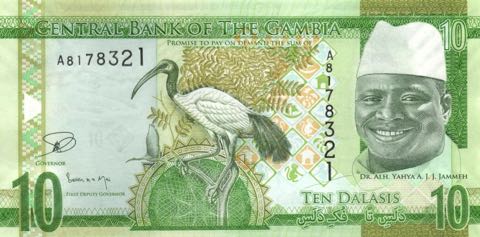

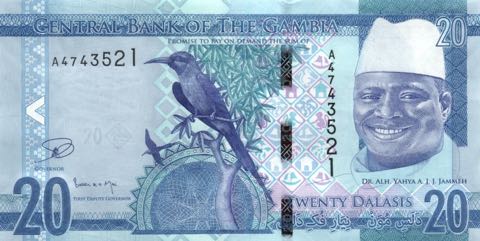
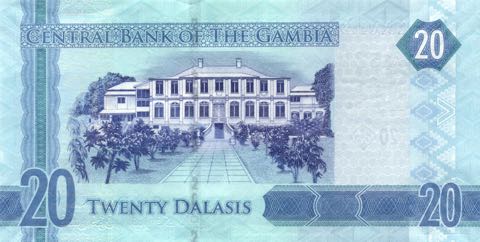

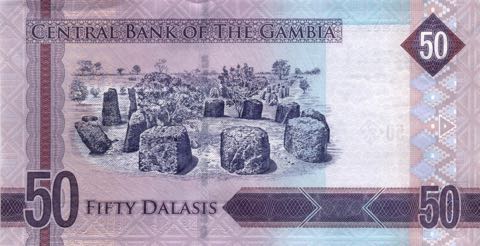
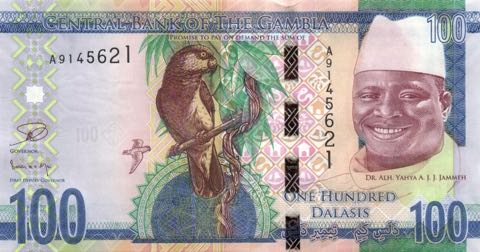
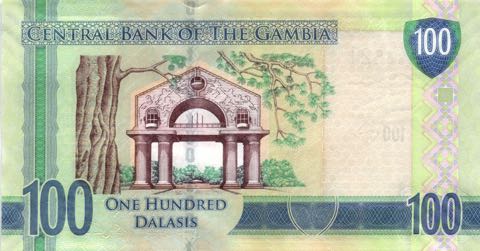

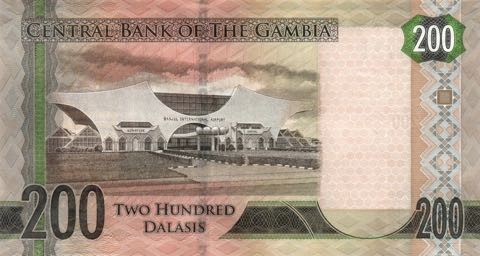
Courtesy of Hartmut Fraunhoffer (Banknote-Online).
Originally scheduled for 30 March 2015, the issuance of these notes was postponed until 15 April 2015 due to a delay in the receipt of publicity materials from the printer, De La Rue.












Courtesy of Hartmut Fraunhoffer (Banknote-Online).
Gambia delays introduction of new note family until 15.04.2015
03 04, 2015 09:36 Category: Africa
PRESS RELEASE
ISSUE OF THE NEW FAMILY OF BANKNOTES
In February, 2015, the Central Bank of The Gambia announced that the new family of Gambian Banknotes including a new D200 banknote will be issued on the 30th March, 2015. Due to delay in the receipt of publicity materials from the printers, the issue into circulation of these banknotes is now slated for 15th April, 2015.
A nationwide sensitization campaign in connection with the issue into circulation of the new family of Gambian banknotes and proper handling of banknotes will commence on the 13th April, 2015.
BANKING DEPARTMENT
30th MARCH, 2015
Courtesy of Claudio Marana.
ISSUE OF THE NEW FAMILY OF BANKNOTES
In February, 2015, the Central Bank of The Gambia announced that the new family of Gambian Banknotes including a new D200 banknote will be issued on the 30th March, 2015. Due to delay in the receipt of publicity materials from the printers, the issue into circulation of these banknotes is now slated for 15th April, 2015.
A nationwide sensitization campaign in connection with the issue into circulation of the new family of Gambian banknotes and proper handling of banknotes will commence on the 13th April, 2015.
BANKING DEPARTMENT
30th MARCH, 2015
Courtesy of Claudio Marana.
Gambia new 20-dalasi note confirmed
05 03, 2015 10:13 Category: Africa
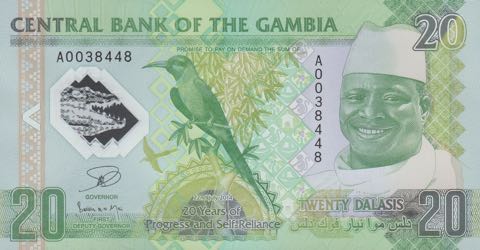

CBG B30 (PNL): 20 dalasis (US$0.60)
Green. Front: Crocodile; carmine bee eater bird in flight and perched on tree branch; monkeys, trees, and boats in underprint; President Yahya Jammeh. Back: State House. No security thread. Watermark: None. Printer: (TDLR). 144 x 75 mm. Polymer (Safeguard).
a. 22nd July 2014. Signature 16. Prefix A. Intro: 02.03.2015.
This note commemorates the 20th anniversary of the revolution of 22 July.
Courtesy of Hartmut Fraunhoffer (www.banknoten.de).
Gambia unveils new note family including 20- and 200-dalasi denominations
26 02, 2015 09:29 Category: Africa
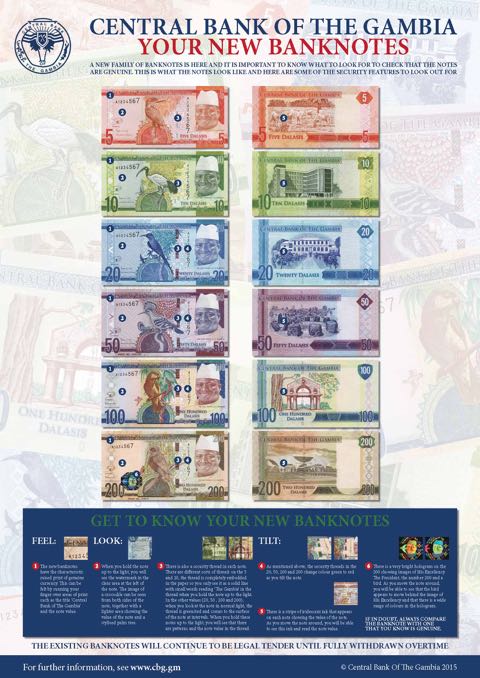

According to an article in The Point dated 26 February 2015, on 25 February the Central Bank of The Gambia launched a new 20-dalasi polymer note, part of a new family of notes, which now includes a 200-dalasi note, twice the size of the previously largest denomination.
Please note that the D20 note shown in the poster above is incorrectly shown as blue with a windowed security thread, whereas the actual note is green without a security thread.
"All of the redesigned banknotes bear the portrait of President Yahya Jammeh and are smaller in size than the existing paper-based banknotes.
The D20 will replace the existing D25 banknote which will continue to be legal tender and will continue to circulate until it is fully withdrawn over time, the release stated.
The historic event held at State House formed part of activities marking the country`s Golden Jubilee.
In his statement, President Jammeh urged Gambians to take ownership of the new banknotes and handle them with care.
He called on the Gambian populace to familiarize themselves with the new banknotes, and help in ensuring their protection from counterfeiters.
He assured De La Rue, the firm that printed the country`s currency, of the government`s continued partnership."
Courtesy of Alex Zlotin.
Gambia new 20-dalasi commemorative polymer note to be introduced at end of 2014
19 11, 2014 11:22 Category: Africa | Commemorative
According to a De La Rue press release dated 18 November 2014, the Central Bank of The Gambia will introduce a 20-dalasi banknote before the end of 2014 to commemorate 20 years in office for President Yahya Jammeh. This note was designed and printed by De La Rue on Safeguard polymer substrate.
This new note is based on the existing paper 25-dalasi note (CBG B24), but is green rather than blue, and features a portrait of the president. The clear window in the polymer note will have an image of a crocodile which currently appears in the watermark of the paper note.
Ruth Euling, Sales Director for De La Rue Currency stated “We are proud to have worked with The Central Bank of The Gambia since its inception and are delighted that they have joined the growing number of banks who have chosen Safeguard for their banknotes. The Gambia is the second country in Africa to issue notes on the Safeguard substrate with a third African country due to issue later this year.”
This new note is based on the existing paper 25-dalasi note (CBG B24), but is green rather than blue, and features a portrait of the president. The clear window in the polymer note will have an image of a crocodile which currently appears in the watermark of the paper note.
Ruth Euling, Sales Director for De La Rue Currency stated “We are proud to have worked with The Central Bank of The Gambia since its inception and are delighted that they have joined the growing number of banks who have chosen Safeguard for their banknotes. The Gambia is the second country in Africa to issue notes on the Safeguard substrate with a third African country due to issue later this year.”
Gambia new signature 50-dalasis note confirmed
30 08, 2013 09:43 Category: Africa
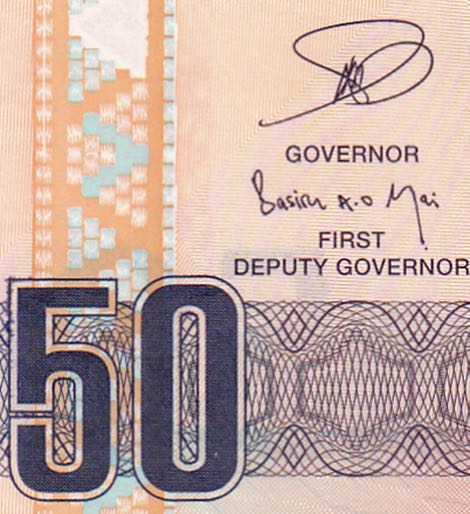
50 dalasis, no date. Like CBG B25, but new signatures (Basiru A. O. Njai and Amadou Colley).
Courtesy of The Monetary Unit.
Gambia new signature 100-dalasi note confirmed
30 07, 2013 12:53 Category: Africa

100 dalasis, no date. Like CBG B27, but new signatures (Basiru A. O. Njai and Amadou Colley).
Courtesy of Семаков Алексей.
Gambia new signature 10-dalasi note confirmed
27 07, 2013 14:17 Category: Africa

10 dalasis, no date. Like CBG B23, but new signatures (Basiru A. O. Njai and Amadou Colley).
Courtesy of Hartmut Fraunhoffer (www.banknoten.de).
Gambia new sig 25-dalasi note confirmed
01 07, 2013 23:17 Category: Africa
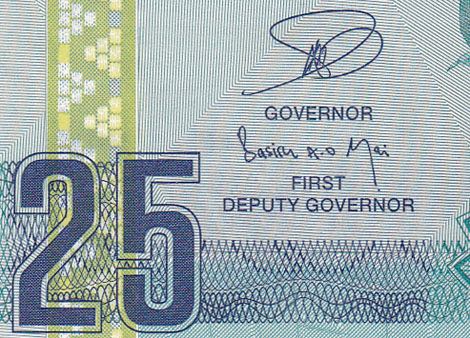
25 dalasis, no date. Like CBG B24 (P27), but new signature (Basiru A. O. Njai and Amadou Colley).
Courtesy of Andrew Roberts.
Gambia new signature 5-dalasis note confirmed
06 01, 2013 10:47 Category: Africa

5 dalasis, no date. Like CBG B22 (P25), but new signature for the governor: Amadou Colley, appointed 03.12.2010. This is the first denomination confirmed bearing the new signature combo.
Courtesy of Ian Fall.
Gambia chapter of The Banknote Book is now available
26 05, 2011 19:19 Category: The Banknote Book | Africa

The Gambia chapter of The Banknote Book is now available for individual sale and as a free download to subscribers.
This 15-page catalog covers notes issued by The Gambia Currency Board in 1964 and the Central Bank of The Gambia from 1971 to present. Revised 21 June 2016.
Each chapter of The Banknote Book includes detailed descriptions and background information, full-color images, and accurate valuations. The Banknote Book also features:
- Sharp color images of note’s front and back without overlap
- Face value or date of demonetization if no longer legal tender
- Specific identification of all vignette elements
- Security features described in full
- Printer imprint reproduced exactly as on note
- Each date/signature variety assigned an individual letter
- Variety checkboxes for tracking your collection and want list
- Date reproduced exactly as on note
- Precise date of introduction noted when known
- Replacement note information
- Signature tables, often with names and terms of service
- Background information for historical and cultural context
- Details magnified to distinguish between note varieties
- Bibliographic sources listed for further research
Subscribe to The Banknote Book
If you collect the entire world or a large number of countries, buying a subscription is the best deal because it's less expensive than buying chapters individually, and it entitles you to every chapter currently available as well as everything published—or revised (click here to see the Change Log)—during the term of your subscription.

Sign up for Email Notifications
If you would like to receive email notifications whenever a new chapter of The Banknote Book is published, please join the email list.

Gambia new 25-, 50-, and 100-dalasis notes confirmed
09 12, 2010 14:17 Category: Africa
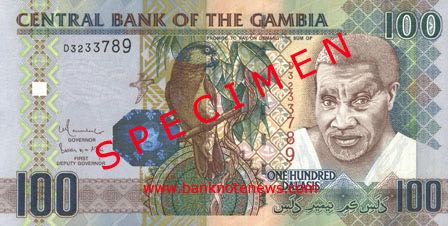
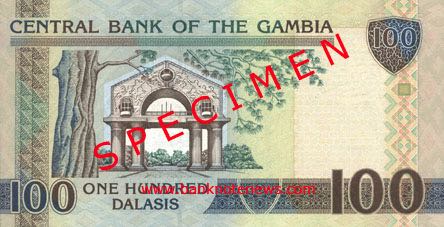

According to an article in The Gambian Banker, on 2 August 2010 the Central Bank of The Gambia issued new 25-, 50-, and 100-dalasis banknotes signed by Governor Momodou B. Saho and First Deputy Governor Basirus A.O. Njai. The notes are essentially unchanged from the preceding issues of the same denominations issued in 2006, except for the 100-dalasis note, which has a Depth Image holographic patch instead of a silver embossed foil. The patch shows the portrait on the banknote with the palm trees alternating with the denomination. When tilted, a flying parrot moves behind the portrait. All current banknotes continue to be legal tender.
Courtesy of Claudio Marana.
British West Africa scans needed for catalog
07 08, 2010 08:13 Category: Africa
I am working on a new catalog of world notes and I need all the help I can get. If you have any of the notes listed below, please email 300-dpi, 100% actual size, 24-bit color scans of the front and back of these notes, saved as uncompressed JPEG, BMP, or TIFF. Please download and follow these detailed scanning instructions.
I am looking for 300-dpi images of the following banknotes of British West Africa:
P3 issued or specimen
P4 with Arabic text on back
P5 with blank back
P6 issued note, not specimen
P7 dated 2ND JANUARY, 1930, 21ST JULY, 1930, 10TH DECEMBER, 1943, 29TH NOVEMBER, 1948, and 28TH JULY, 1950
P8 dated December, 1947
P11 dated 31ST MARCH 1953
As a contributor, you will receive the satisfaction of taking part in creating something of excellence, your note will be immortalized as the plate note for the catalog, plus your name will appear in the Acknowledgements along with your email address or URL, if you wish.
Thanks in advance for everyone's cooperation!
I am looking for 300-dpi images of the following banknotes of British West Africa:
P3 issued or specimen
P4 with Arabic text on back
P5 with blank back
P6 issued note, not specimen
P7 dated 2ND JANUARY, 1930, 21ST JULY, 1930, 10TH DECEMBER, 1943, 29TH NOVEMBER, 1948, and 28TH JULY, 1950
P8 dated December, 1947
P11 dated 31ST MARCH 1953
As a contributor, you will receive the satisfaction of taking part in creating something of excellence, your note will be immortalized as the plate note for the catalog, plus your name will appear in the Acknowledgements along with your email address or URL, if you wish.
Thanks in advance for everyone's cooperation!
Gambia new signature 10-dalasis note confirmed
29 03, 2010 14:14 Category: Africa
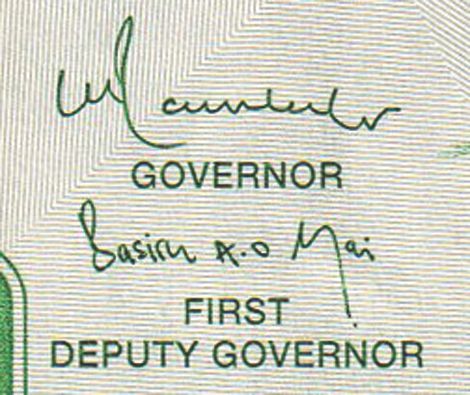
10 dalasis (US$0.40), no date. Introduced 16.04.2009. Like Pick 26, but new signatures: Governor Saho and First Deputy Governor Njai.
Courtesy of Andrew Roberts.
Gambia new signature 5-dalasis note confirmed
30 11, 2009 08:33 Category: Africa
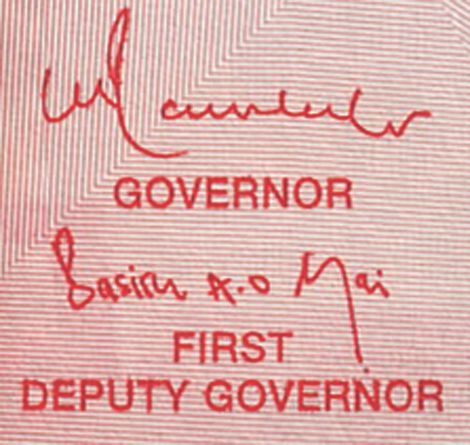
5 dalasis (US$0.20), no date. Red. Front: Giant kingfisher bird; young Gambian girl. Back: Man with cattle in field; palm trees. Solid security thread printed THE GAMBIA. Watermark: Crocodile head. Printer: (TDLR). 132 x 69 mm. Introduced 16.04.2009. Like Pick 25, but new signatures: Governor Saho and First Deputy Governor Njai.
If anyone has the new D10 note also bearing these signatures, please send scans of same so that I can share them with others.
Courtesy of Richard Miranda.
Gambia issues new signature varieties 16.04.2009
24 06, 2009 08:46 Category: Africa
According to a press release from the Central Bank of The Gambia, on 16 April 2009, the bank “issued into circulation new D5 and D10 banknotes [US$0.20 and 0.40]. This is the first series of banknotes issued by the Bank since the appointment of Governor Momodou Bamba Saho [on 01.08.2007] and First Deputy Governor Basiru A. O. Njai. The new notes bearing the signatures of Governor Saho and First Deputy Governor Njai, are a reprint of the current design banknotes [Pick 25 and 26]. The design and features of these banknotes are similar to the current family of new design banknotes introduced in 2006. The new D5 and D10 banknotes will circulate side by side with the current existing banknotes. All current existing banknotes continue to be legal tender.”
Gambia issues new note series
14 07, 2006 11:01 Category: Africa
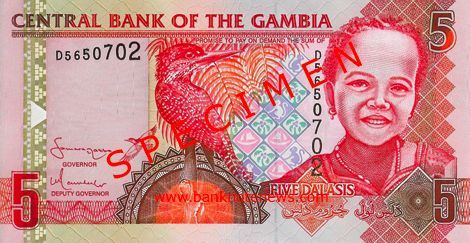
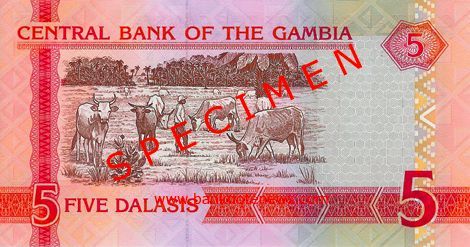
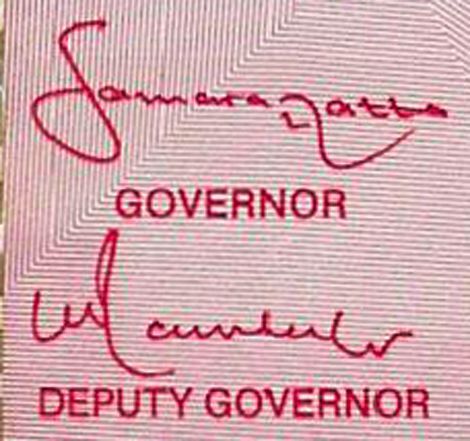
The following text is from a press release issued by the Central Bank of The Gambia on 14 July 2006:
“As part of continuing efforts to improve the security, durability and aesthetic quality of The Gambia’s banknotes, the Central Bank of The Gambia is pleased to announce the introduction of new design legal tender banknotes with effect from Thursday, 27 July 2006.
“According to international best practice, central banks introduce significant banknote design and security feature changes every six to eight years. This continuous cycle of design change enables central banks to be proactive in meeting threats from counterfeiters and maintaining public confidence in their currencies. The Gambia’s banknote design upgrade was postponed because of the scheduled implementation of monetary union in the West African Monetary Zone by July 2005 and the planned eventual introduction of a single currency for the Zone. However, in May 2005, the deadline for the launch of monetary union was rescheduled to December 2009. Since then, the Central Bank has been collaborating with its banknote printers, De La Rue Currency [www.delarue.com], to upgrade The Gambia’s banknotes.
“The Gambian currency has undergone a series of changes since it was introduced in 1971. These include reduction in size, use of more sophisticated inks and dyes, improved security features and printing techniques, and the introduction of higher denomination notes, the D50 and D100. The last major design change was done in 1996 when the portrait of the former Head of State [Sir Dawda Kairaba Jawara] was replaced with generic images.
“The new design banknotes will be similar to the current family of banknotes [Pick 20 - 24] to maintain continuity but will include improvements in the design, paper thickness and security features.
“The design of the banknotes would be modified to remove all the ‘white paper’ areas. The notes would be printed all over. This makes the notes less susceptible to accumulating dirt and would thus last longer. In addition, the box-like borders, especially on the back of the notes, have been removed to give the notes a more ‘open design’ look. The Gambia’s banknotes have contained these borders since 1971. This makes them look outdated. An ‘open design’ gives the banknotes a more modern look. The vignette on the back of the D10 banknote now features the Central Bank building.
“In addition to design changes, steps have also been taken to improve durability. The most important of these is to increase the paper thickness. In addition, the D5 and D10 would be coated with a special varnish after printing. This should extend the average circulation life of the banknotes. The security features of the D100 would also be upgraded by the inclusion of a silver foil on the front of the note with the image of 100 embossed into the foil. The Central Bank will continue to honour the existing banknotes at face value as long as they remain in circulation. The new family of banknotes will circulate side by side with the current existing banknotes. The current existing banknotes will continue to be legal tender until such a time as the stock is retired from circulation. As notes are returned to the Central Bank through the usual distribution channels, those in poor condition will be phased out of circulation. It is anticipated that this gradual phasing out will take several years to complete. A program of gradual introduction of the new design banknotes is considered the most cost-effective and practical means of undertaking this important exercise.”
Courtesy of Chris Twining.

